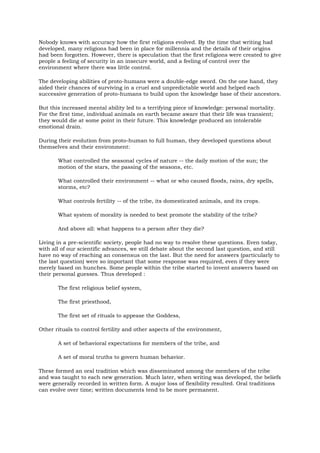
Origins and Evolution of Early Religions
- 1. Nobody knows with accuracy how the first religions evolved. By the time that writing had developed, many religions had been in place for millennia and the details of their origins had been forgotten. However, there is speculation that the first religions were created to give people a feeling of security in an insecure world, and a feeling of control over the environment where there was little control. The developing abilities of proto-humans were a double-edge sword. On the one hand, they aided their chances of surviving in a cruel and unpredictable world and helped each successive generation of proto-humans to build upon the knowledge base of their ancestors. But this increased mental ability led to a terrifying piece of knowledge: personal mortality. For the first time, individual animals on earth became aware that their life was transient; they would die at some point in their future. This knowledge produced an intolerable emotional drain. During their evolution from proto-human to full human, they developed questions about themselves and their environment: What controlled the seasonal cycles of nature -- the daily motion of the sun; the motion of the stars, the passing of the seasons, etc. What controlled their environment -- what or who caused floods, rains, dry spells, storms, etc? What controls fertility -- of the tribe, its domesticated animals, and its crops. What system of morality is needed to best promote the stability of the tribe? And above all: what happens to a person after they die? Living in a pre-scientific society, people had no way to resolve these questions. Even today, with all of our scientific advances, we still debate about the second last question, and still have no way of reaching an consensus on the last. But the need for answers (particularly to the last question) were so important that some response was required, even if they were merely based on hunches. Some people within the tribe started to invent answers based on their personal guesses. Thus developed : The first religious belief system, The first priesthood, The first set of rituals to appease the Goddess, Other rituals to control fertility and other aspects of the environment, A set of behavioral expectations for members of the tribe, and A set of moral truths to govern human behavior. These formed an oral tradition which was disseminated among the members of the tribe and was taught to each new generation. Much later, when writing was developed, the beliefs were generally recorded in written form. A major loss of flexibility resulted. Oral traditions can evolve over time; written documents tend to be more permanent.
- 2. Unfortunately, because these belief systems were based on hunches, the various religions which developed in different areas of the world were all different. Their teachings were in conflict with each other. Because the followers of most religions considered their beliefs to be derived directly from God, they could not be easily changed. Thus, inter-religious compromise was and is difficult or impossible. Also, because religious texts are often ambiguous, divisions developed within religions. Different denominations, schools, or traditions have derived different meanings from the same religious texts. Thus were laid the foundations for millennia of inter-religious and intra-religious conflict. Evolution of religion: The first organized religions appear to have been based on fertility. They were focused on the worship of the great Earth Goddess. Religion evolved to include male Gods who were gradually given increased importance by the priests. This development may have been caused by developing knowledge of the male's involvement in the process of reproduction. Today, most people follow either a monotheistic religion, in which a single male god is worshipped, or a henotheistic religion - a religion which recognizes a single main deity, but which recognizes other gods and goddesses, heroes, or saints as facets or manifestations or aspects of that supreme God. Most religions teach that they were directly revealed by their deity/deities to humanity, and are unrelated to other world religions. However there is considerable historical evidence from ancient times that religions in the area from India to the Middle East shared many religious beliefs. Religions were originally based on the particular beliefs of their founders and prophets. Thus, there were few points of similarity among the various religious paths. In terms of their belief about supernatural being(s), various faith traditions have taught Agnosticism, Animism, Atheism, Deism, Duotheism, Henotheism, Monism, Monotheism, Panentheism, Pantheism, Polytheism, Trinitarianism, and probably a few that we have missed. It is obvious from these conflicting ideas about deities that almost all religions are just plain wrong. Few agreements exist among the world's religions about religious beliefs, sacred ritual, organizational structure, optimum family structure, personal sexual behavior, etc. Religions' traditional teachings in the area of science differ greatly from each other and from the findings of scientists. Examples are: how the universe was formed, where rainbows came from; the world-wide flood; talking animals; the sun standing still in the sky; the cause of epilepsy, deafness, blindness, and mental illnesses; demonic possession, etc.